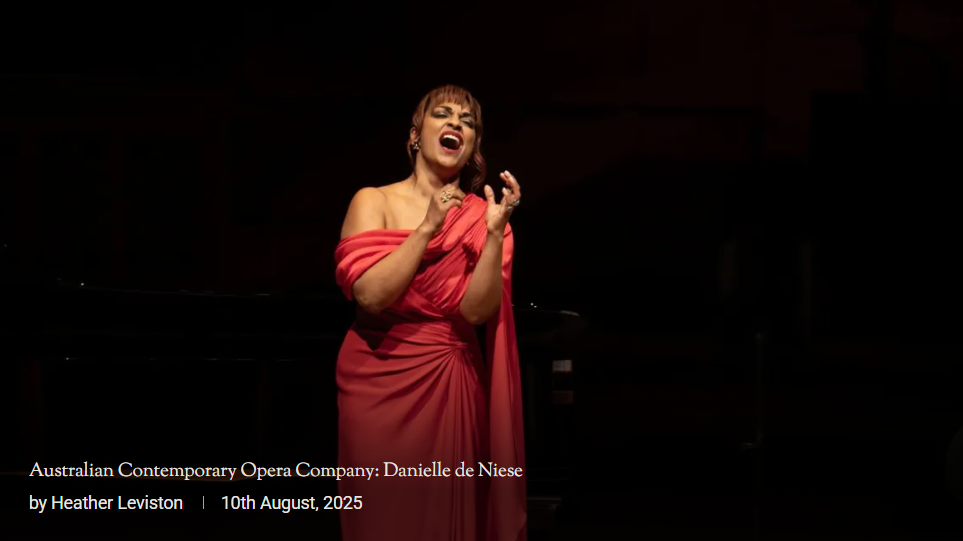
by Heather Leviston 10th August, 2025

As one of Australia’s most enterprising small independent opera companies, Australian Contemporary Opera Company (ACOCO) has continued to bring a range of innovative performances to Melbourne audiences since 2008. Showcasing an international opera star of the calibre of Danielle de Niese, however, is an unusual achievement even for them.
What was more typical, however, was the inclusion of gifted young local singers joining her on stage. This followed masterclasses earlier in the week when de Niese shared her extensive experience and encouraged them to hone their talents. The choice of repertoire is another element that distinguishes ACOCO’s work under Artistic Director, Linda Thompson.
The first half of the program comprised ten pieces “from Handel to Hannibal”, as presenter, comedian Annie Louey, put it – an eclectic mix that included pieces never heard before. Even Handel’s “Gia nel seno” and Marcello’s “Pace non trovo” were Australian premieres in arrangements by Glynn Davies (b. Melbourne 1973). Both works are supremely beautiful – a compensation for those who had hoped to hear the Baroque coloratura fireworks that are such a spectacular feature of de Niese’s vocal armoury. What made these pieces even more satisfying was having some of the cream of Melbourne’s classical musicians as associate artists: a string quartet of Curt Thompson violin, Sophie Rowell violin, Lisa Grosman viola, and Richard Narroway, cello, plus Rachel Curkpatrick for the Marcello oboe obbligato.
Although the unduly loud amplification of Louey’s introductions came with the possibility of making singers and instrumentalists sound comparatively pale, there was no danger of this happening with de Niese. With the acoustic blinds fully retracted, the resonant acoustic of the Elisabeth Murdoch Hall revealed a soprano voice of exceptional power right from the first piece (another Australian premiere), “You were destined to come here” from Bel canto (after the novel by Ann Patchett) by Jimmy Lopez (1978- ). The texts of all pieces were included in the program, giving listeners a fuller appreciation of poetry. De Niese did her best to project clear diction, and her expressive acting skills conveyed essential meaning, but it is not always easy to follow poetic text sung by sopranos, no matter how easy and luminous their vocal production. From languorous to passionate, this opening song revealed a soprano voice of extraordinary quality: superb breath control, strength on the lower notes, free and ringing resonance on the top notes, a breathtakingly gorgeous pianissimo, and never the hint of anything untoward in the vibrato.
In a short “interview” with Louey, de Niese spoke about her career and enthusiasm for contemporary music. Accompanied by über-versatile pianist Coady Green, she created a totally different atmosphere for the second programmed piece, singing the dual roles of Anna 1 and Anna 2 in the Prologue from The Seven Deadly Sins, by Kurt Weill and Berthold Brecht. Vocal style and gesture conveyed the distinctive theatrical mood of this work.
Two more Australian premieres, Soul Song and The Vows, composed for her by Sir James Macmillan (1959-), were works that de Niese said that she saw as “making them my own”. And that she did. The first moved from tense and dramatic to slow and gentle with a tinkling piano accompaniment, whereas The Vows was slow and atmospheric with a very sparse contribution from piano. She sang Michael Symmons Roberts’ text with great feeling. Also moving was her account of Courage, by Christopher Tin (1976-) with a text by Amelia Earhart – another Australian premiere. Dedicating this performance with strings and piano to her parents, de Niese found special significance in this stirring and most appealing work.
Following a short talk about the masterclasses, one of the participants, Sophie Bisset sang Where from The Rabbits, by Australian composer by Kate Miller-Heidke, with libretto by Lally Katz. It begins serenely, Bisset admirably composed and with a captivatingly attractive, natural quality to her soprano voice. Mainly in the style of a gentle ballad, the score has a couple of demanding climaxes, with high notes that stretched Bisset’s vocal technique, although she managed creditably. She is a singer to be watched.
The spotlight was also on Callum Warrender singing Moon’s aria from The Enchanted Pig by Sir Jonathan Dove – an opera in ACOCO’s repertoire. Warrender gave a lively performance, his strong tenor voice showing considerable promise. Uma Dobia was a calm, focused participant in the small role of Flora.
All instrumentalists, including harpist Marshall McGuire joined de Niese and the seven young singers from ACOCO’s Rising Artist program for “Vide cor meum” (featured in the film Hannibal). In an arrangement by Glynn Davies, Patrick Cassidy’s music concluded the first part of the program.
Apart from de Niese herself, Coady Green was the busiest person on the stage. With the exception of the final work, Leonard Cohen’s Hallelujah, which brought all artists back onto the stage, he was the sole accompanist after interval. His ability to switch idioms and establish mood – uptempo, laid-back, jazz, contemplative, dramatic – he was there with de Niese, skilled, supportive and stylish.
Always vibrant and up for a fabulous time, de Niese was as much at home in the Broadway numbers. Gershwin, Bernstein and Jerome Kern were given the full de Niese treatment. She also luxuriated in the intimacy of Hal Cazalet’s Song for Nature and did full justice to the beauty of John Denver’s Rhymes and Reasons. There were vocal embellishments in these numbers that few others could achieve, and her floating descant for Cohen’s Halleluja was perfect. With subtle movements she “conducted” the ensemble to synchronised excellence.
What this listener appreciated almost as much as the wonderful singing was the fact that absolutely everything was sung and played without amplification. What a relief! ACOCO and its financial supporters deserve a mighty “Bravo!” for providing such a memorable experience.

Leave a Reply